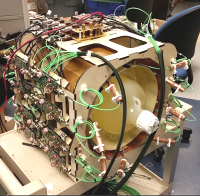Magnetic resonance imaging (MRI) creates anatomical images by detecting magnetization in the human body. Prior to being detected, the magnetization must be "excited," which is typically done by applying a powerful radio-frequency magnetic field, referred to as the RF transmit field. However, the RF transmit field is potentially harmful to certain patients, especially those with implanted devices. By separating the RF transmit system into an array of smaller antennas and amplifiers working in parallel, the hazard is reduced, making it possible for millions of patients with implants to benefit from high field MRI.
Contact:
Michael Tweig , mdt24@case.edu


